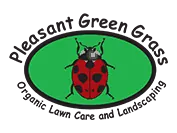Hiring a professional organic lawn care and landscaping company like Pleasant Green Grass is a great way to get a hassle free lawn. We have found that some of our customers choose to take care of the weekly maintenance themselves and offer these tips!

Proper mowing techniques are extremely important. If you’re not doing it properly you’re causing problems for your grass.
Here are the most frequently asked questions:
How do you control weeds?
Weeds are symptoms of poor growing conditions and imbalances in the soil. By getting the soil balanced we are able to get the weeds under control. This thickness of the turf also helps discourage weed growth. As the soil improves the grass growing thicker and healthier making it harder for weeds to come up.
Are your products safe?
All of our products are completely safe for people, pets, insects, and the environment. We don’t use any synthetic products or chemicals of any kind.
How long do I need to stay off the lawn after your treatment?
There is no requirement for staying off the lawn.
How does the payment process work?
We charge the card you have on file after each service has been completed using our secure online payment system.
How do your costs compare to conventional lawn care companies?
Initially we are a little higher than conventional lawn care, because we’re fixing your soil using high quality products that build soil health Over time, once we have fixed your soil issues, we end up being less expensive than conventional lawn care.
Do you do a soil test?
Absolutely. We use an out of state lab to get a highly detailed report of your soil composition. This helps us fine tune the program to meet the needs of your particular lawn.
How soon will I see results?
You should start to see an improvement in the appearance of the grass after we start our treatments. Weed control takes longer as it takes awhile to get the soil issues corrected.
Mowing
Proper mowing techniques are extremely important. If you’re not doing it properly you’re causing problems for your grass. Here are the most frequently asked questions.
How short do I cut my fescue grass?
Fescue should be mowed at no less than 3.5″. If you can mow higher that’s even better. It’s easy to “burn” or “scalp” a lawn with one improper mowing job and it’s hard for the lawn to recover from that.
How short do I cut my warm season grass?
Warm season grass (bermuda, zoysia, centipede, st augusine) should be mowed much shorter, between 1-2″.
Should I leave my clippings or collect them?
Conventional wisdom tells you to collect your clippings when you mow. This is not a good practice. When you collect and remove grass clippings you are removing vital nutrients from your lawn. Our whole focus is improving the soil and maintaining proper nutrient levels in the soil. If you remove clippings you are removing the nutrients.
How about flowering weeds?
Shouldn’t I remove the clippings when weeds are flowering? The answer is NO. Yes, yo may spread weed seeds around when you mow, but seeds are already there. Every lawn is covered with hundreds of thousands of weed seeds. The whole earth is covered in weed seeds. However, they need certain conditions to germinate, ie sunlight and moisture. If you’re mowing properly that will help create thicker turf and make it harder for seeds to germinate. Weeds also need certain conditions to thrive, unbalanced soil. If your soil isn’t balanced the weeds that do germinate will thrive. The only way to balance your soil is have it tested and amended.
When do I start mowing my fescue grass?
You should mow your fescue as soon as it gets above 3.5″. In early spring the winter annual weeds are hitting their growth spurt before the fescue wakes up, so your weeds may out grow the fescue. You can certainly mow those weeds, just set your mower height to cut the weeds andnot the grass.
When do I start mowing my warm season grass?
Warm season grass (bermuda, zoysia, centipede, st augusine) should not be mowed until the last threat of frost has passed, April 15th. After April 15th you can start mowing your warm season grass. The initial cut should be extra short. That will allow more sunlight in and help stimulate growth. If this initial cut creates a lot of clippings, then you should mow over the lawn a second time to help cut and disperse the clippings. In early spring the winter annual weeds are hitting their growth spurt before the warm season grass wakes up, so your weeds may out grow your grass. You can certainly mow those weeds, just set your mower height to cut the weeds and not the grass.
How often should I mow?
You should mow frequently enough so that you’re not removing more than 1/3 of the grass blade at once. So, if you’re keeping it mowed at 3.5″ you should cut it when it gets to 4.5″. This usually means weekly mowing during the spring and fall- maybe less in the summer depending on the weather. If you wait too long in between cuts you will produce clippings that may clump together. These clumps will kill the grass underneath if not raked up.
Should I water after mowing?
NO. Try not to water within 24 hours of mowing. A freshly cut grass blade is like an open wound and water is the ideal carrier for disease. That open wound will heal in about 24 hours and then it’s ok to water.
How often should I sharpen blades?
Sharpen your blades 1-2 times per season. A sharp blade will create a
clean cut that heals faster. Dull blades tear the grass creating unsightly white tips and leaving the grass more vulnerable to disease. Proper mowing helps to reduce weed seed germination, conserves soil moisture and increases overall grass health. Utilizing proper cultural practices is crucial to the health and success of an Organic lawn.
Additional Tips
- Try to change the direction you cut every week. For example: cut up and down one week, back and forth the next week and then diagonal the next. This will help reduce soil compaction and stress on your lawn.
- Sharpen mower blades. A dull mower blade will rip the grass instead of cutting it. This will leave a very noticeable white tip on the grass blade taking away from the aesthetic appearance of your lawn. A ripped blade will also take longer to heal leaving the grass more susceptible to disease.
Watering FAQ
When is the best time to water my lawn? It is best to water early in the morning as it mimics the natural moisture grass gets from dew. Early watering will also allow the grass time to dry during the day discouraging disease and fungus. Adding our Water Saver will help reduce watering needs and conserve water. However, if watering early in the morning is not possible, water late at night instead.
When should I water? Water deeply and infrequently. The idea is to let water get down to the root zone (6-8 inches) and then let the soil dry out before watering again. This will encourage the roots to dig deep and the deeper the roots are the healthier the grass will be. Watering too frequently or shallow will cause a shallow root system.
We will provide you with any tips that we can in order to help you choose environmentally friendly and non-toxic lawn care choices.
Want a beautiful, chemical free, safe lawn to enjoy? We make getting a quote easy so give us a call today at 919-357-8245.


